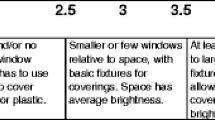Abstract
This study examined relationships between the quality and appropriateness of housing environments and community adjustment of 729 deinstitutionalized severely mentally ill clients in a state-wide community support service program. Environmental measures included ratings of the physical condition of the client's residence, its adequacy for six key life activities, and the overall appropriateness of the residential setting for the client. Community adjustment measures included global level of functioning, degree of maladaptive behavior and client's perceived quality of life. Evidence is presented that quality and appropriateness of housing environments significantly affect aspects of client's community adjustment outcomes over a nine-month period.
Similar content being viewed by others
References
Andrews, R.E., & Withey, S.B. (1976).Social indicators of well-being: Americans' perceptions of life quality. New York: Plenum Press.
Anthony, W.A., Cohen, M.R., & Vitalo, R. (1978). The measure of rehabilitation outcome.Schizophrenia Bulletin, 4, 365–383.
Baker, F., & Intagliata, J. (1982). Quality of Life in the evaluation of community support systems.Evaluation and Program Planning, 5, 69–79.
Baker, F., & Intagliata, J. (1984). The New York State Community Support System: A profile of clients.Hospital & Community Psychiatry, 35, 39–44.
Baker, F., & Intagliata, J. (1983).CSS evaluation final report. Submitted to the New York State Office of Mental Health. Albany, New York.
Baker, F. (1988). An approach to evaluating state-funded community support services for the chronically mentally ill. In B.L. Blackwell & L.K. Cartwright,Program consultation with human with human service programs: A clinical perspective, (pp. 155–163). Oakland, CA: Third Party Press.
Bigelow, D.A., Brodsky, G., Steward, L. and Olson, M. (1982). The concept and measurement of quality of life as a dependent variable in evaluation of mental health services. In W. Tash and G. Stahler (Eds.)Innovative Approaches to Mental Health Evaluation (pp. 345–366). New York, New York: Academic Press.
Boyer, C.A. (1987). Obstacles in urban housing policy for the chronically mentally ill. In D. Mechanic (Ed.),Improving mental health services: What the social sciences tell us: New directions for mental health services, (no. 36). San Francisco: Jossey-Bass.
Endicott, J., Spitzer, R.L., Fleiss, J.L., & Cohen, J. (1976). The global assessment scale.Archives of General Psychiatry, 33, 766–771.
Intagliata, J., & Baker, F. (1984). The New York State community support system: A profile of clients.Hospital and Community Psychiatry, 35, 45–50.
Lehman, A.F. (1983). The well-being of chronic mental patients, assessing their quality of life.Archives of General Psychiatry, 40, 369–373.
Lipton, F.R., Nutt, S., & Sabatini, A. (1988). Housing the homeless mentally ill: A longitudinal study of a treatment approach.Hospital and Community Psychiatry, 39, 40–45.
Randolph, F.L., Laux, B., & Carling, P.J. (1987).In search of housing. Burlington, VT: University of Vermont Center for Change through Housing and Community Support.
Test, M.A. (1981). Effective community treatment of the chronically mentally ill: What is necessary?Journal of Social Issues, 37, 71–86.
Wandersman, A., & Moos, R.H. (1981). Assessing and evaluating residential environments: A sheltered living environments example.Environment and Behavior, 13, 481–508.
Author information
Authors and Affiliations
Additional information
The author gratefully acknowledges the assistance of James Intagliata, david Mandell, Harry Straus, and David jodrey in the collection and analysis of the data reproted here. These data were collected as part of an evaluation of the New York State CSS program funded by a contract between the New York State Office of Mental Health and the Psychotechnical Applied Research Organization, Inc. of Buffalo, New York. Preparation of this paper has been partially supported by NIMH Grant No. MH 43703. A version of this paper was presented at the American Public Health Association Annual Meeting in Boston, MA on November 16, 1988.
Rights and permissions
About this article
Cite this article
Baker, F., Douglas, C. Housing environments and community adjustment of severely mentally ill persons. Community Ment Health J 26, 497–505 (1990). https://doi.org/10.1007/BF00752454
Issue Date:
DOI: https://doi.org/10.1007/BF00752454




